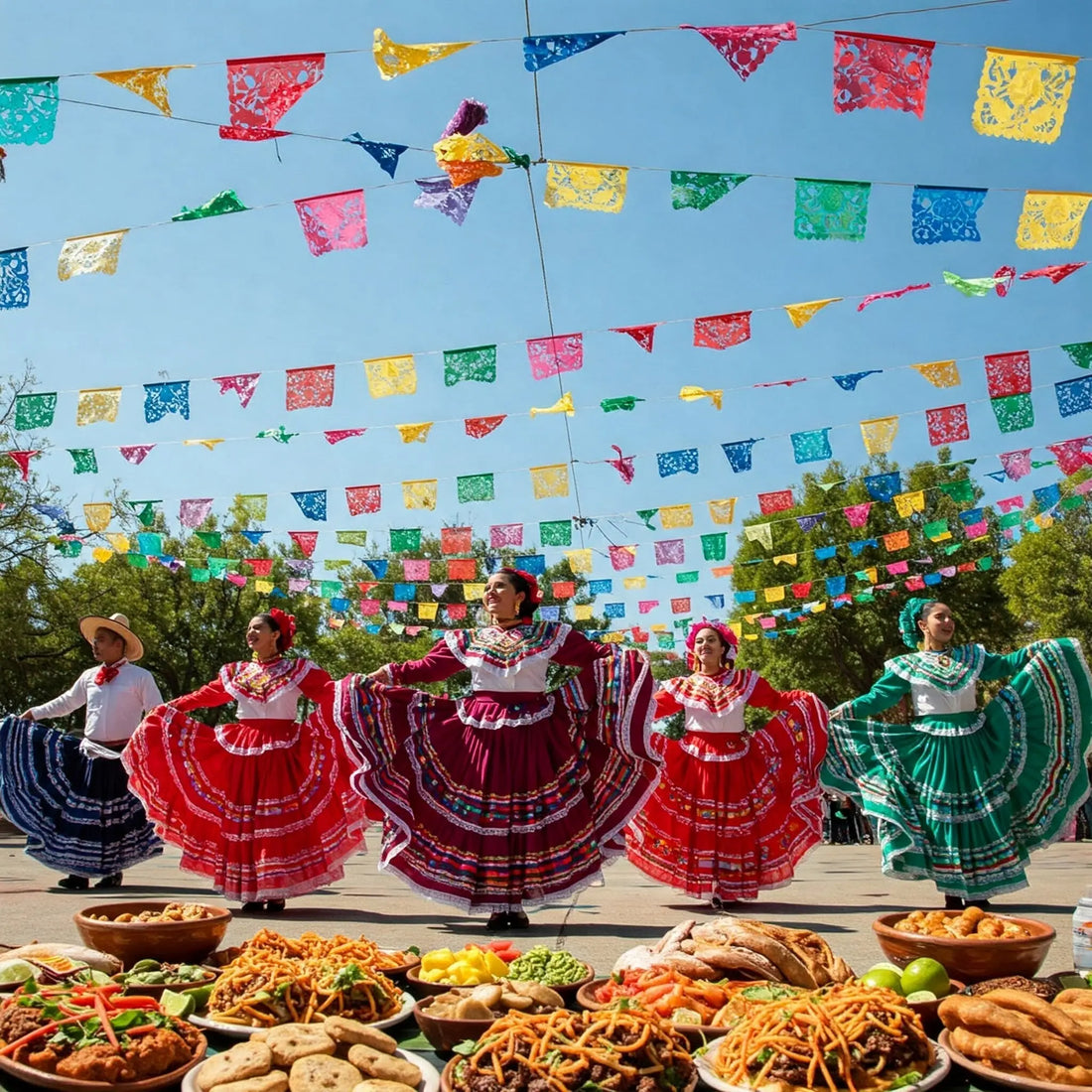Cinco de Mayo, observed every year on the 5th of May, is a vibrant celebration rich in history, culture, and symbolism. Often mistaken in the United States as Mexico's Independence Day, Cinco de Mayo commemorates the Mexican Army's remarkable victory over the French Empire at the Battle of Puebla on May 5, 1862. Over time, this historic event has evolved into a broader celebration of Mexican heritage and pride, particularly in the United States, where it has taken on new dimensions.
At Glam Origins, we celebrate not just African heritage but the richness of all global cultures and humanity. Cinco de Mayo perfectly aligns with our belief in honoring history, resilience, and the vibrant diversity that shapes our world.
The Historical Significance of Cinco de Mayo
The roots of Cinco de Mayo trace back to a period of economic hardship for Mexico. In the early 1860s, Mexico, struggling financially after years of internal conflict, was forced to default on debts to European powers. France, under Napoleon III, seized the opportunity to extend its influence in the Western Hemisphere by invading Mexico.
Despite being poorly equipped and outnumbered, the Mexican Army, led by General Ignacio Zaragoza, achieved an unlikely victory against the French forces in Puebla. This victory served as a powerful symbol of resistance and resilience for the Mexican people. Although France eventually succeeded in taking Mexico City and establishing the short-lived Second Mexican Empire under Emperor Maximilian I, the Battle of Puebla remains a source of immense national pride.
Cinco de Mayo vs. Mexican Independence Day
One of the most common misconceptions is that Cinco de Mayo is Mexico's Independence Day. In reality, Mexico celebrates its independence from Spanish rule on September 16th. Cinco de Mayo is significant for its representation of unity and determination in the face of overwhelming odds, rather than the achievement of sovereignty.
The Evolution of Cinco de Mayo in the United States
Cinco de Mayo began gaining traction in the United States in the mid-20th century, particularly during the Chicano Movement of the 1960s. Mexican-Americans embraced the holiday as a way to celebrate their cultural identity and history. Over the decades, the celebration expanded beyond the Mexican-American community and evolved into a broader appreciation of Mexican culture.
Today, Cinco de Mayo is marked by parades, festivals, music, folklórico dancing, mariachi performances, and, of course, a delightful array of Mexican cuisine. Cities like Los Angeles, Chicago, Houston, and San Antonio host some of the largest and most vibrant Cinco de Mayo events in the country.
Cultural Symbols and Traditions
1. Music and Dance: Traditional Mexican music, including mariachi, banda, and norteño, fills the air during Cinco de Mayo festivities. Folklórico dancers, clad in colorful, flowing dresses, perform traditional dances that tell stories of Mexican heritage.
2. Cuisine: Food is central to Cinco de Mayo celebrations. Tacos, enchiladas, tamales, mole poblano (a dish said to have originated in Puebla), and guacamole are popular dishes. Festive drinks like margaritas and Mexican beer also feature prominently.
3. Parades and Festivals: Parades showcasing Mexican cultural pride are a highlight of Cinco de Mayo. Floats, traditional costumes, and reenactments of the Battle of Puebla bring history to life.
4. Symbols: The Mexican flag, adorned with its iconic eagle and serpent emblem, waves proudly at celebrations. Traditional decorations often include vibrant colors, papel picado (decorative paper banners), and piñatas.
The Global Reach of Cinco de Mayo
While primarily celebrated in Mexico and the United States, Cinco de Mayo has gained recognition in various parts of the world. In Canada, the Cayman Islands, Jamaica, Australia, and even parts of Europe, communities come together to honor Mexican culture through food, music, and festivities.
In Puebla itself, the day remains a solemn occasion marked by military parades and reenactments, honoring the bravery and sacrifice of those who fought against the French forces.
The Commercialization of Cinco de Mayo
In recent years, some critics have noted the commercialization of Cinco de Mayo, particularly in the United States. The holiday has been heavily marketed by beverage companies, bars, and restaurants as an opportunity for themed promotions and parties. While these celebrations can be fun and inclusive, it is important to remember and respect the historical and cultural significance behind the holiday.
Educational Opportunities
Cinco de Mayo also offers a valuable opportunity for education and cultural exchange. Schools often incorporate lessons about Mexican history, culture, and traditions during this time, fostering greater understanding and appreciation among students of all backgrounds.
How to Celebrate Cinco de Mayo Respectfully
If you're planning to join the festivities, consider these ways to honor the true spirit of Cinco de Mayo:
· Learn the History: Take some time to understand the origins and significance of the Battle of Puebla.
· Support Authentic Mexican Businesses: Enjoy food, art, and crafts from Mexican-owned businesses.
· Attend Cultural Events: Look for events that focus on traditional music, dance, and historical education.
· Respect the Culture: Avoid cultural appropriation by steering clear of insensitive costumes or stereotypes.
Fun Facts About Cinco de Mayo
· General Zaragoza was only 33 years old when he led Mexican forces to victory.
· Mole Poblano, a rich, chocolate-tinged sauce, is said to have been created in Puebla and is often associated with Cinco de Mayo.
· Los Angeles hosts one of the largest Cinco de Mayo celebrations in the world, with its "Fiesta Broadway" event drawing hundreds of thousands of attendees.
· The Battle of Puebla was significant not only for Mexico but also for the United States; some historians argue that a French victory in Mexico could have altered the outcome of the American Civil War by enabling France to support the Confederacy.
Cinco de Mayo in Modern Times
As society becomes more interconnected and multicultural, Cinco de Mayo serves as a reminder of the strength found in diversity and the importance of understanding each other's histories. The holiday provides a platform for showcasing the richness of Mexican traditions while inviting others to celebrate and learn.
In recent years, there has been a growing movement towards "decolonizing" the way Cinco de Mayo is celebrated. This means moving away from purely commercialized, surface-level festivities and towards a deeper engagement with Mexican culture, history, and contributions.
Traditional Recipes to Try on Cinco de Mayo
Want to bring a taste of Mexico to your celebration? Here are a few traditional dishes to try:
· Mole Poblano: A complex sauce made with chilies, chocolate, spices, and more, often served over chicken.
· Tacos al Pastor: Pork marinated in a blend of chilies, spices, and pineapple, cooked on a vertical spit.
· Chiles en Nogada: Poblano peppers stuffed with picadillo (a mixture of meat, fruits, and spices) topped with a walnut-based cream sauce and pomegranate seeds, representing the colors of the Mexican flag.
· Guacamole and Salsa: Fresh, vibrant dips perfect for starting your feast.
Conclusion: Honoring Heritage and Humanity
Cinco de Mayo is far more than an excuse for a festive party; it is a day that marks the courage and resilience of a people who stood against the odds. It is an opportunity to celebrate the richness of Mexican culture, to educate ourselves and others, and to build bridges of understanding across communities.
At Glam Origins, we believe in celebrating all cultures, heritage, and the shared spirit of humanity. Cinco de Mayo reminds us of the importance of unity, respect, and pride in our collective histories.
So, this Cinco de Mayo, let's raise a glass — not just to good times, but to the heroes of Puebla, to the beauty of Mexican culture, and to the connections that bring us all closer together.

